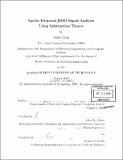| dc.contributor.advisor | John W. Fisher. | en_US |
| dc.contributor.author | Kim, Junmo, 1976- | en_US |
| dc.contributor.other | Massachusetts Institute of Technology. Dept. of Electrical Engineering and Computer Science. | en_US |
| dc.date.accessioned | 2005-09-27T19:40:19Z | |
| dc.date.available | 2005-09-27T19:40:19Z | |
| dc.date.copyright | 2000 | en_US |
| dc.date.issued | 2000 | en_US |
| dc.identifier.uri | http://hdl.handle.net/1721.1/8982 | |
| dc.description | Thesis (S.M.)--Massachusetts Institute of Technology, Dept. of Electrical Engineering and Computer Science, 2000. | en_US |
| dc.description | Includes bibliographical references (p. 111-112). | en_US |
| dc.description.abstract | Functional MRI is a fast brain imaging technique which measures the spatio-temporal neuronal activity. The development of automatic statistical analysis techniques which calculate brain activation maps from JMRI data has been a challenging problem due to the limitation of current understanding of human brain physiology. In previous work a novel information-theoretic approach was introduced for calculating the activation map for JMRI analysis [Tsai et al , 1999]. In that work the use of mutual information as a measure of activation resulted in a nonparametric calculation of the activation map. Nonparametric approaches are attractive as the implicit assumptions are milder than the strong assumptions of popular approaches based on the general linear model popularized by Friston et al [19941. Here we show that, in addition to the intuitive information-theoretic appeal, such an application of mutual information is equivalent to a hypothesis test when the underlying densities are unknown. Furthermore we incorporate local spatial priors using the well-known Ising model thereby dropping the implicit assumption that neighboring voxel time-series are independent. As a consequence of the hypothesis testing equivalence, calculation of the activation map with local spatial priors can be formulated as mincut/maxflow graph-cutting problem. Such problems can be solved in polynomial time by the Ford and Fulkerson method. Empirical results are presented on three JMRI datasets measuring motor, auditory, and visual cortex activation. Comparisons are made illustrating the differences between the proposed technique and one based on the general linear model. | en_US |
| dc.description.statementofresponsibility | by Junmo Kim. | en_US |
| dc.format.extent | 112 p. | en_US |
| dc.format.extent | 6357856 bytes | |
| dc.format.extent | 6357615 bytes | |
| dc.format.mimetype | application/pdf | |
| dc.format.mimetype | application/pdf | |
| dc.language.iso | eng | en_US |
| dc.publisher | Massachusetts Institute of Technology | en_US |
| dc.rights | M.I.T. theses are protected by copyright. They may be viewed from this source for any purpose, but reproduction or distribution in any format is prohibited without written permission. See provided URL for inquiries about permission. | en_US |
| dc.rights.uri | http://dspace.mit.edu/handle/1721.1/7582 | |
| dc.subject | Electrical Engineering and Computer Science. | en_US |
| dc.title | Spatio-temporal fMRI signal analysis using information theory | en_US |
| dc.title.alternative | Spatio-temporal functional magnetic resonance imaging signal analysis using information theory | en_US |
| dc.type | Thesis | en_US |
| dc.description.degree | S.M. | en_US |
| dc.contributor.department | Massachusetts Institute of Technology. Department of Electrical Engineering and Computer Science | |
| dc.identifier.oclc | 47210830 | en_US |
